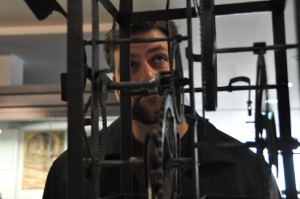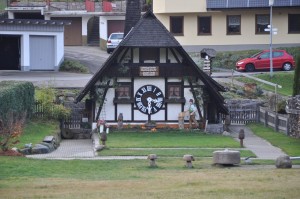There are some things in life that you know you just have to do, regardless of how you really feel about them. Owning a Cuckoo Clock was one of these things for me.
I have always found them kind of unattractive. May I even say garish? I also knew that a Cuckoo Clock would require care – daily re-setting of the weights, dusting, hourly ear-covering, etc. My wind-up Mickey Mouse wrist watch was taken away when I was a kid because I didn’t take care of it well enough. On several occasions I have watched my Mom get up every half hour for an entire day just to re-set our Grandfather clock. How in the world could I be responsible for the up-keep of a Cuckoo Clock? I wasn’t particularly in the mood for a high-maintenance time piece. Joe, however, has been looking forward to picking out the perfect Cuckoo for months now.
Instead of waiting (and dreading) this necessary step in life, I jumped right in a planned an entire day of “clocking” in the Black Forest. If more than two hours for this task seems excessive to anyone, let it be known that throughout southern Germany, there are over 200 miles dedicated to clocks on the Deutsche Uhrenstraße (German Clock Street). One day seemed appropriate. It turned out to be a great day!
 First stop was the German Clock Museum in Furtwangen. Big clocks, little clocks, Cuckoo Clocks, watches….you name it…it was about clocks. The best moment was when the musical clock room came to life unexpectedly. What good is a Saturday without a little song and dance in the clock museum? (Yes, we really did a little jig.)
First stop was the German Clock Museum in Furtwangen. Big clocks, little clocks, Cuckoo Clocks, watches….you name it…it was about clocks. The best moment was when the musical clock room came to life unexpectedly. What good is a Saturday without a little song and dance in the clock museum? (Yes, we really did a little jig.)
 Then we headed to Schönwald, the “birthplace” of the Black Forest Cuckoo Clock. Historical reports vary, but somewhere around 1735 Franz Ketterer debuted his “invention”. A humble little monument, outside of town, is the only indicator of this man’s enormous contribution to German culture. It felt like we were in a mini-episode of Amazing Race trying to find it, but we were successful. It was strangely located in someone’s yard, between the cows and the front door, but that didn’t stop us.
Then we headed to Schönwald, the “birthplace” of the Black Forest Cuckoo Clock. Historical reports vary, but somewhere around 1735 Franz Ketterer debuted his “invention”. A humble little monument, outside of town, is the only indicator of this man’s enormous contribution to German culture. It felt like we were in a mini-episode of Amazing Race trying to find it, but we were successful. It was strangely located in someone’s yard, between the cows and the front door, but that didn’t stop us.
Next came Triberg. Other than being the shopping-mecca of Cuckoo Clocks, this town has very little significance in the history of Black Forest clocks. We stopped in the tourist trap first. The tags were in English and even included VAT-free prices, which meant that Americans (especially military members) were a common occurrence. I knew long ago that a piece of Cuckoo Tchotchke made in China was exactly what I didn’t want, so I actually spent time looking up carvers and authentic clock makers in the Black Forest. I wanted my Cuckoo to come right from the source.
We headed to one of the locations I scouted and started looking again. The info on the web included a photo of the owner and master carver. When we were approached in the store I made the mistake of asking if he was the carver. Despite our attempts at speaking German and Joe’s beard, what this apparently really said was, “I’m an American military member…I’m a tourist…and I don’t know what I am talking about.” Sometimes you just have to swallow your pride when you have an inkling that the end result will be beneficial. What the carver proceeded to give us as a very valuable education in clock-making and the deception of commercialism.
His lesson was based on questions: “Why are the beer-drinkers pouring the beer over their shoulders again and again instead of drinking it?” I don’t know. “Why is the dog as big as the man?” I don’t know. “As long as it says “Made In Germany,” you think it is good right?” Yes. “Wrong.”“What kind of bird does this look like?” A chicken. “Right, why would you want a chicken in your clock?” Well, actually, come to think of it, I don’t. (He then walked us to a stuffed Cuckoo bird so we knew exactly what to look for inside the clock.) “How many weights does a real clock need?” I don’t know. “Why do you want a clock that is battery operated?” I don’t. “How can you tell if the wood was carved by hard or on a spindle?” I can’t, but I’m sure you will tell me. “Do you think I care which one you buy, as long as I get your money?” No, you obviously do not.
He was the epitome of German-directness. I was seeing my clock-future in a new light.
We looked around and carefully weighed all the options, inspecting the intricacies and details of every bird, beer-drinker, and clock hand.
Two stops left. Next was the First World’s Biggest Cuckoo Clock in Schonach. Sadly, this  was closed for a month so we had to settle with a view from the street. The World’s Biggest Cuckoo Clock in Schonachbach was the last stop. At the top of the hour, everyone lined up outside to see what would happen as the big hand hit the XII. Huge letdown, but perhaps I was expecting the Cuckoo bird to come out and put on a personal song and dance for me….and not a Chicken dance.
was closed for a month so we had to settle with a view from the street. The World’s Biggest Cuckoo Clock in Schonachbach was the last stop. At the top of the hour, everyone lined up outside to see what would happen as the big hand hit the XII. Huge letdown, but perhaps I was expecting the Cuckoo bird to come out and put on a personal song and dance for me….and not a Chicken dance.
To sum up the day, I am now the proud owner of a Black Forest Cuckoo Clock. It is big, and tacky, and noisy, and I love it!
My tip for anyone who is walking the fence about Cuckoo Clock ownership (or who has one at home against your will) is to take some time to shift your perspective. Remember that guy/girl in High School who made you think, “no thanks”, at first look? Perhaps you did a few projects or assignments together and got to know each other a bit, sharing a few laughs or inside jokes. And then, after some time, he/she didn’t look so bad anymore, right? The same phenomena will happen with Cuckoo Clocks, if you just give them a chance.
